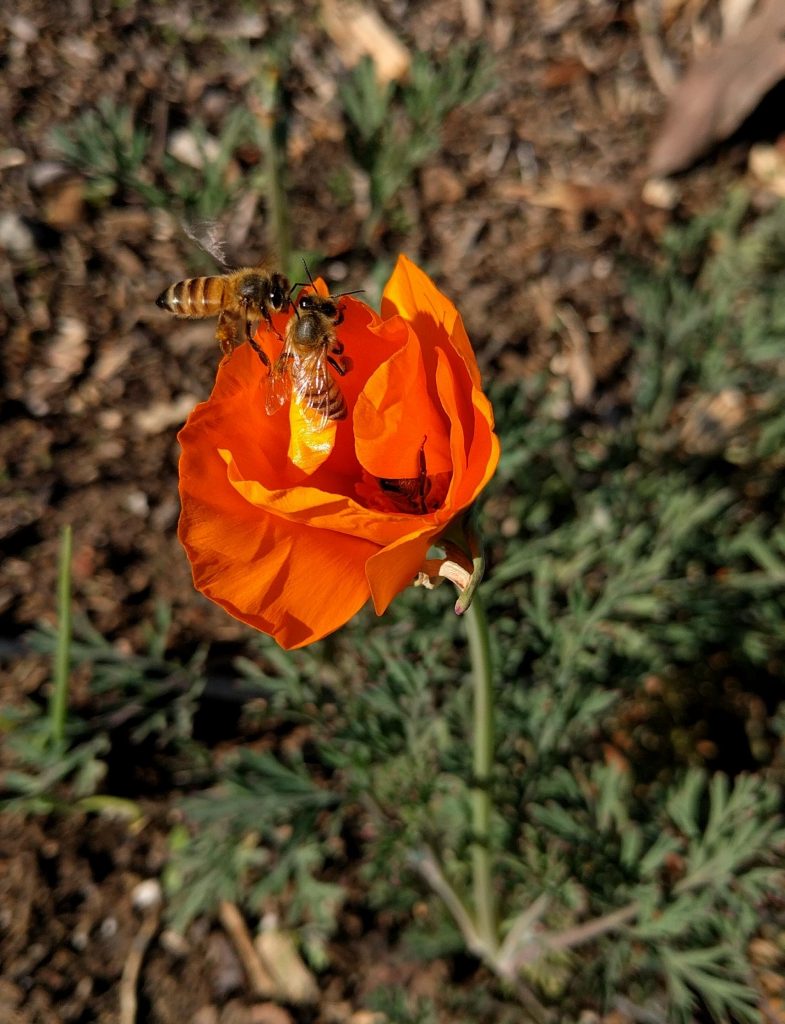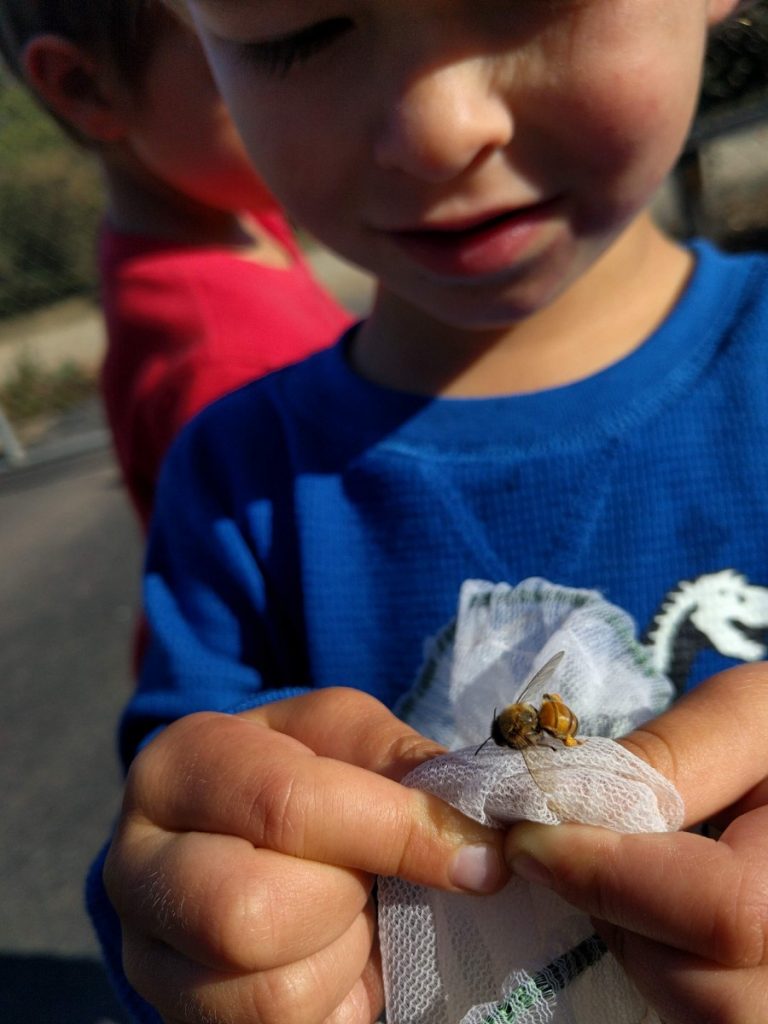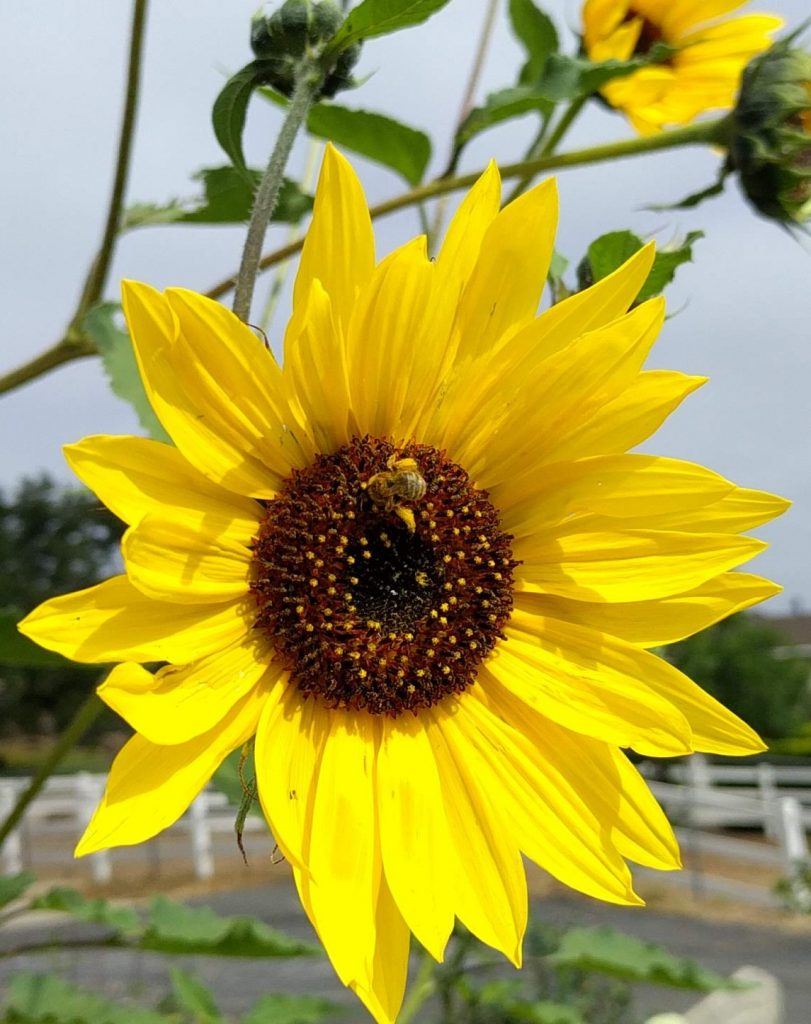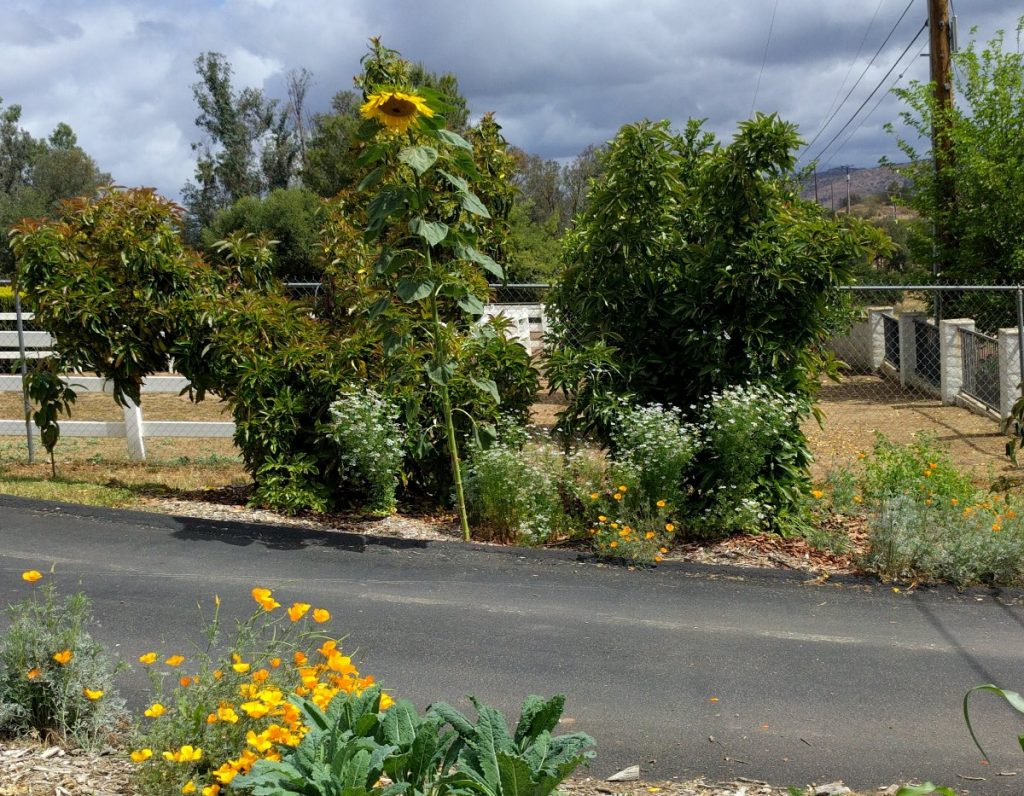California Bees and Blooms has become my guide to a more lively, colorful, and fruitful yard. Just a few mornings ago, I photographed bees collecting pollen on a California poppy flower, one of the first to open this winter. There was lots of buzzing and flashes of neon orange petals. The poppy patch is among my vegetables, and it is near many fruit trees, all of which will feed my family more through the pollination activities of more bees.

You may remember a post I wrote last winter about the relationships between flowers and bees and the world of wild, California native bees that was opened up to me when I attended a talk in the summer of 2017 by Gordon Frankie, an entomologist at U.C. Berkeley. Frankie is the lead author of California Bees and Blooms.
(Last winter’s post is linked here: “Oh, the mistakes I’ve made: Thinking flowers were for girls”)
Also contributing to the book are entomologists Robbin Thorp and Rollin Coville. And bringing expertise about blooms is botanist Barbara Ertter.
A guide, not a textbook
The book is a guide; it is not a textbook. The full title is California Bees and Blooms: A Guide for Gardeners and Naturalists. A guide to what? What does it aim to help us do?
In the foreword, the question is posed: What happens when valleys and mountain slopes become suburbs and cities? You might expect a jeremiad to follow: We’ve chainsawed and bulldozed so much native vegetation that we’ve also killed off native bees. Not entirely. The next words are, “Fortunately, as you will read, many of the state’s bees are easily coaxed back into urban areas.”
The goal of the book, then, is to both educate us about native bees and provide us with tools to act on their behalf.
An education
The first chapter is indeed an education, and I’ll admit that it does have more of a textbook feel than later chapters. In chapter one we learn basic facts about bees. For example, most native bees don’t make honey and don’t live in hives. Here our native bees are contrasted with the better known honey bees which were originally brought over from Europe. Throughout the book, honey bees are referred to even though they aren’t native and they aren’t the focus of the book.
We also learn about the parts of a bee’s body (proboscis, thorax, ocelli, etc.) and seasonal behaviors of various bees (foraging for nectar, mating, building brood chambers, etc.).
Tools to act
Then the bulk of the remaining chapters of the book is about acting, about how to do things.
The second chapter is about how to observe bees. You may think that sounds insulting it’s so basic. But have you ever observed a bee by putting it in the fridge?
Catching bees
I learned to do this from California Bees and Blooms. In fact, my sons and I caught one of the honey bees I was photographing on the poppy flower and put it in the fridge. After about twenty minutes next to the cauliflower in the crisper, you can take the bee out of the fridge and hold it in your hand. It won’t fly away; it won’t sting. The bee is cold and sleepy.

We inspected the orange pollen on its legs that it had collected from the poppy flower, we noticed the hairs on its back, the length of its antennae compared to some native bees. Eventually, it woke up and flew away.
Kinds of bees
The book next profiles some of the kinds of native bees that we’re most likely to see in our gardens: sweat bees, digger bees, carpenter bees, squash bees, mason bees, etc. The photographs included are beautiful and impressive and mostly taken by Rollin Coville. They are particularly impressive to me because I’ve been trying to photograph some of these frenetic fliers. Most native bees fly much faster than honey bees.
Here is a long-horned bee that I photographed last summer (check out all the yellow pollen on that little guy!):

Bee plants
Then there is a transitional chapter that explains how bees use flowers and how flowers use bees. Following that, we have profiles of bee plants. These plants are the tools that we can use to attract bees into our yard.
This chapter is an outgrowth of the Urban California Native Bee Survey, where various gardens throughout our state were monitored for bee activity. The plants profiled are those that were not only found to attract many native bees, but can also be grown in most of the state and are easily available for purchase from nurseries or seed companies.
Some of these bee plants are native, some are not. Some require irrigation, some do not. Some are annuals, like sunflowers, which only live a season and then die; some are perennials, like ceanothus, which live for many years.
All of the plants profiled in this chapter of California Bees and Blooms that I’ve grown in my yard have definitely attracted many bees, both native and honey bees. It seems to be a very reliable list.
Recipes for bee gardens
“Over time, a garden can be transformed into an inviting native bee habitat by slowly introducing new bee-attractive plants and allowing existing patches of bee plants to grow in size.” Here is chapter eleven, which is about how to put together everything we’ve learned about bees, flowers, and their relationship so that our garden becomes more lively, colorful, and fruitful.
It’s perhaps the most useful chapter. It’s about which plants to choose, how to arrange them, and how to provide nesting habitat for bees. The majority of native bees nest in the ground and can’t dig into a lawn or a deep mulch in order to build their nests. For me, this means I must leave some bare ground for nesting habitat.
There are “recipes” for gardeners who prefer native plants, for gardeners who like to grow food plants, even for gardeners who don’t have much time to garden.
These recipes for bee-friendly gardens are turnkey. You could take one to a nursery and buy the plants straight off the list, go home and plant them in the suggested design, and watch the bees arrive.
Plant in patches
How do I know? For years, I’ve been growing many of the plants on the list, but (stupid me!) only in the last couple years have I listened to the design advice in California Bees and Blooms.
I now realize that I’ve been making the mistake of planting single, lonely plants rather than larger patches of plants.
Last year, I started planting patches in a couple areas. One of the patches was near a few avocado trees, and the flowers (mostly cilantro, poppies, parsley, phacelia, and sunflowers) were constantly dancing with the visits of many species of bees. The bees also visited the avocado flowers. Those avocado trees ended up with more fruit than others in my yard — maybe just a coincidence, but a promising outcome nonetheless.

Why are patches better than single plants? As California Bees and Blooms helped me understand, bees want to get their food economically. They don’t want to fly a hundred feet to a few flowers and then another hundred feet to another plant with a few more flowers. They want a bunch of flowers all together in a big, fat smorgasbord.
This winter I’m developing two more larger patches. Right now, winter, is the best time to do this, as seeds are easily germinated in the mild weather and native plants are easiest to get established. I can’t wait to see the buzz of life arrive over the coming months . . . and then eat the resulting cornucopia of fruits and vegetables from my garden that have been incidentally pollinated.
If you’d like to learn more about native bees, and especially if you’d like to make your garden more welcoming to them, I recommend California Bees and Blooms. See California Bees and Blooms at Amazon here.
(A few my other favorite gardening books for California, along with reviews, can be found here.)
You might also like to read my post:




Hi Greg, Do you speak on bees? I have wanted to have a speaker on bees come to our Lake San Marcos Garden Club. You have spoken to us previously about citrus. We would love to have you back.
Hi Chris,
Yes, I remember talking about it last year. I’d love to join you guys again and talk about bees this time. I feel like I’m far enough down the road learning about them to be able to give a substantive presentation now although I’m still by no means an expert.
Please email me to talk dates, etc.
Dang bees are amazing plain and simple. Now we’re going to have to try the new trick we learned from your post to observe one. Thanks for the educational and interesting post.
Thanks Joel!
Mason will love it. To catch a bee, you just hold a bag over the top of it and it will instinctively fly up into the bag. (I use a mesh bag, but pretty much any kind of bag will work.) Fifteen to thirty minutes in the fridge is usually a good amount of time. There’s lots of honey bees around right now, but you’ll find more native bees in the spring and summer. Let me know how it goes.